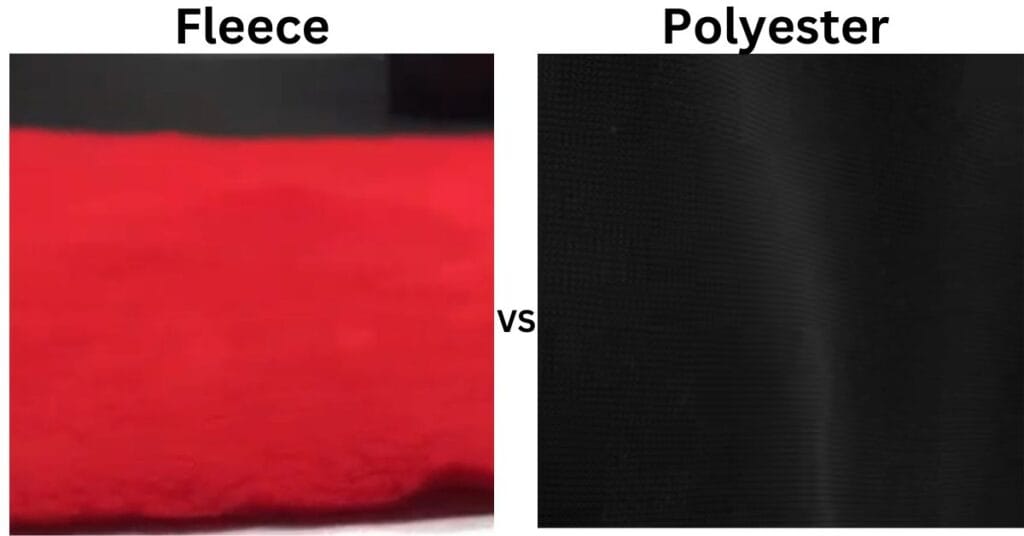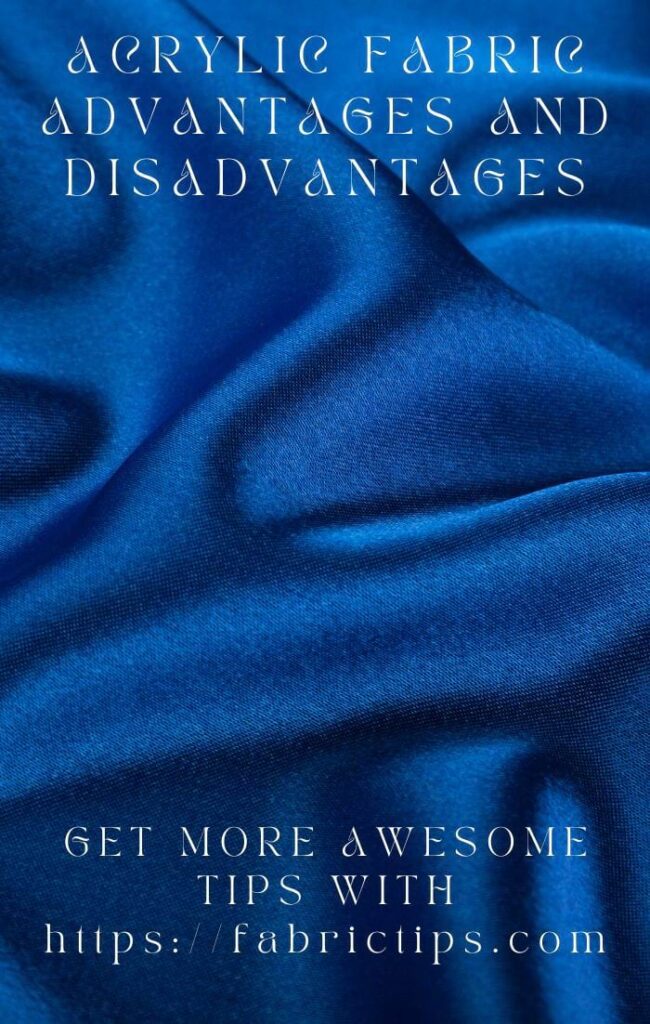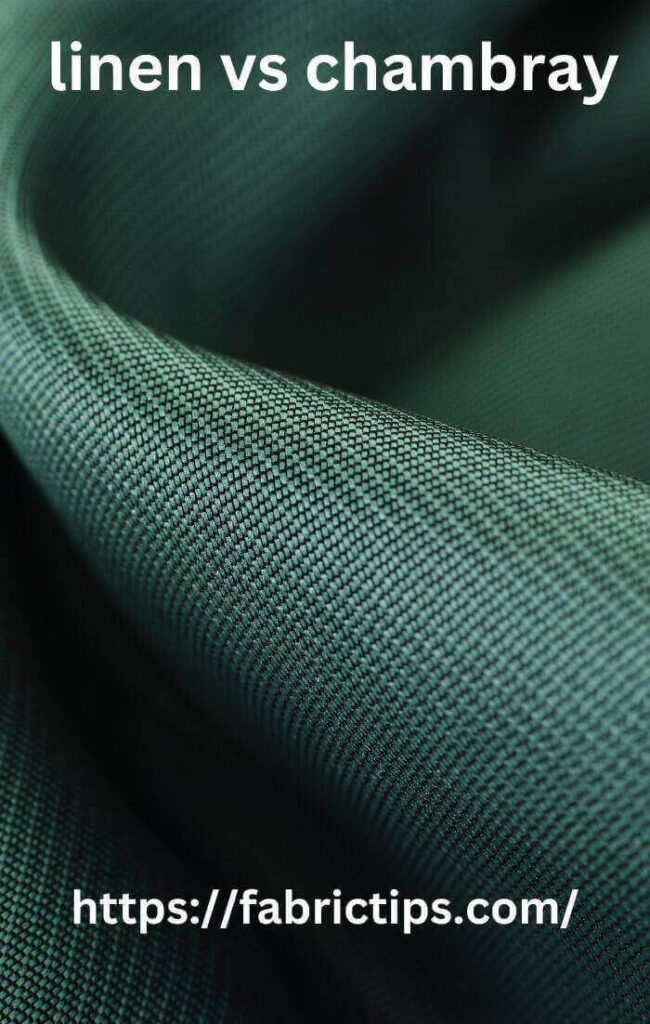Last Updated on December 13, 2025 by Wahid
Fleece or polyester? When it comes to comfy clothes and cozy blankets, these two fabrics are often the go-to choices. But with both Fleece Vs Polyester offering warmth and softness, how do you decide which one reigns supreme?
For decades, fleece and polyester have dominated the world of comfortable textiles. Fleece is usually made from polyester, or polyurethane which is essentially the same thing equally polyester. However, Polyester is a fiber type; thus, it can be applied to many various types of fabric. Although fleece is a type of fabric, based upon the knitting technique & finishing procedure applied to it.
This guide dives deep into the fascinating world of fleece and polyester, unpacking their unique properties, strengths, & weaknesses. We’ll explore the science behind their comfort, ideal uses, & ultimately help you choose the right one for your specific needs. Hence, buckle up and get ready for the ultimate fleece vs polyester showdown!
Fleece: The Champion of Cozy Warmth

Fleece, often mistaken for a specific fiber type, is actually a fabric construction that boasts a delightfully cozy characteristic. Unlike cotton or wool, which are natural fibers, fleece can be crafted from various materials, including:
- Polyester: This synthetic fiber is the most common fleece material, offering affordability and durability.
- Cotton: Fleece made from cotton or cotton blends provides a more natural feel and breathability.
- Wool: Wool fleece offers exceptional warmth and moisture-wicking properties, but can be more expensive and require special care.
Regardless of its fiber content, fleece is known for its signature features:
- Softness: The fluffy texture of fleece creates a luxuriously soft feel against the skin.
- Warmth: The air trapped within the fabric’s fibers provides excellent insulation, making fleece ideal for chilly weather.
- Lightweight: Despite its warmth, fleece is surprisingly lightweight, offering comfortable wear without feeling bulky.
- Fuzziness: Fleece often features a fuzzy texture on one or both sides, contributing to its softness and warmth.
These properties make fleece a popular choice for a variety of cozy applications:
- Loungewear: Fleece sweatpants and sweatshirts are a staple for relaxation and comfort at home.
- Activewear: Fleece base layers provide warmth and moisture-wicking properties for low-intensity workouts.
- Winter Wear: Fleece jackets and hats offer a comfortable and warm layer for winter activities.
- Blankets and Throws: Fleece blankets are known for their snuggly softness, perfect for curling up on the couch.
- Stuffed Animals: The cuddly nature of fleece makes it a popular material for creating adorable and huggable stuffed toys.
Polyester: The Versatile Champion

On the other side of the comfort ring stands polyester, a true powerhouse in the textile world. Unlike fleece, which is a fabric construction, polyester is a synthetic fiber derived from petroleum. This man-made marvel boasts an impressive range of properties:
- Durability: Polyester fibers are incredibly strong and resilient, making them resistant to tears, abrasions, and shrinking.
- Wrinkle Resistance: Say goodbye to ironing! Polyester garments naturally resist wrinkles, maintaining a crisp and polished look.
- Fast-Drying: Polyester wicks away moisture and dries quickly, making it ideal for activewear and wet weather conditions.
- Versatility: A true chameleon, polyester can be manipulated to mimic the look and feel of various natural fabrics like cotton, silk, or wool.
This versatility has propelled polyester to the forefront of textile applications, making it a common component in:
- Clothing: From everyday shirts and dresses to high-performance sportswear, polyester is ubiquitous in modern clothing.
- Home Textiles: Bed sheets, curtains, and even carpets often incorporate polyester for its durability and easy care.
- Industrial Applications: Polyester’s strength and versatility make it a valuable material for industrial uses like ropes, sails, and even medical textiles.
Yes, it’s important to acknowledge that the production of polyester relies on fossil fuels and can contribute to environmental concerns. However, advancements in recycled polyester production offer a more sustainable alternative.
Fleece vs. Polyester: Head-to-Head Comparison
Here’s a breakdown of key features to help you decide between fleece and polyester:
| Feature | Fleece | Polyester |
| Material Source: | Natural (cotton, wool) or Synthetic (polyester) | Synthetic |
| Warmth: | Excellent (traps air) | Varies (depends on thickness) |
| Breathability: | Low (not ideal for high-intensity activities) | Moderate (breathable, but less than natural fibers) |
| Moisture Wicking: | Moderate (wicks some moisture, but not as effective as other fabrics) | Excellent (wicks moisture away from the body) |
| Durability: | Good, but can pill (form small balls of fabric) over time | Excellent (resistant to tears, abrasions, and shrinking) |
| Wrinkle Resistance: | Low (wrinkles easily) | Excellent (wrinkle-resistant) |
| Ease of Care: | Machine washable and dries quickly | Machine washable and dries quickly |
| Cost: | Generally affordable | Can range from affordable to high-end depending on quality |
| Sustainability: | More sustainable if made from natural fibers or recycled polyester | Less sustainable due to reliance on fossil fuels, but recycled options are becoming more available |
Fleece: Pros and Cons
Fleece, the champion of cozy comfort, offers a range of benefits that make it a beloved fabric choice:
Pros:
- Unmatched Comfort: The soft, fuzzy texture of fleece creates a luxuriously comfortable feel against the skin, making it ideal for lounging and relaxation.
- Excellent Warmth: The air trapped within the fabric’s fibers provides exceptional insulation, keeping you warm on chilly days.
- Lightweight Champion: Despite its impressive warmth, fleece is surprisingly lightweight, allowing for comfortable wear without feeling bulky.
- Budget-Friendly: Fleece is generally an affordable fabric option, making it a cost-effective choice for cozy clothing and blankets.
- Easy Care: Fleece is typically machine washable and dries quickly, requiring minimal maintenance for everyday use.
However, like any champion, fleece has its challengers in the form of a few drawbacks:
Cons:
- Low Breathability: The dense nature of fleece can trap heat and moisture, making it less breathable and less ideal for high-intensity activities.
- Pilling Woes: Over time, fleece can develop a fuzzy texture known as pilling, which can detract from its appearance.
- Durability Concerns: While comfortable, fleece may not be as durable as some other fabrics and can be susceptible to tears or snags.
Ultimately, fleece excels in creating cozy comfort at an affordable price. However, its breathability limitations and potential for pilling make it less suitable for high-intensity workouts or situations requiring maximum durability.
Polyester: Pros and Cons
Polyester, the ever-reliable and adaptable fabric, boasts a range of advantages that have cemented its place in the textile world:
Pros:
- Durability King: Polyester fibers are incredibly strong and resilient, making them resistant to tears, abrasions, and shrinking. Clothes made with polyester can last for a long time, making them a cost-effective choice in the long run.
- Wrinkle-Free Champion: Forget the iron! Polyester garments naturally resist wrinkles, maintaining a crisp and polished look, perfect for busy lifestyles.
- Quick-Drying Hero: Sweating it out? No problem! Polyester wicks away moisture and dries quickly, keeping you comfortable during exercise or in humid conditions.
- Versatility Master: A true chameleon, polyester can be manipulated to mimic the look and feel of various natural fabrics like cotton, silk, or wool. This allows for a wide range of clothing and home textile applications.
- Budget-Friendly: Polyester can be a very affordable fabric choice, especially when compared to some natural fibers. This makes it a popular option for everyday clothing and household items.
However, even the most versatile champion has its weaknesses:
Cons:
- Breathability Blues: Polyester is not as breathable as natural fibers like cotton. This can trap heat and moisture, making it less comfortable for high-intensity activities or hot weather.
- Sweat Trapper: Due to its lower breathability, polyester can trap sweat, leading to a feeling of dampness during exercise.
- Environmental Impact: The production of virgin polyester relies on fossil fuels and can contribute to environmental concerns. However, recycled polyester offers a more sustainable alternative.
While breathability limitations can be a drawback for activewear, polyester’s durability, wrinkle resistance, and versatility make it a champion for everyday clothing, home textiles, and various other applications.
Similarities Between Fleece and Polyester
Despite their differences, fleece and polyester share some key characteristics that contribute to their widespread popularity:
- Warmth Champions: Both fleece and polyester offer varying degrees of warmth depending on the fabric’s thickness and construction. Thicker fleece or polyester jackets provide excellent insulation for cold weather, while lighter fleece or polyester base layers offer comfortable warmth for layering.
- Easy Care Champs: Let’s hear it for minimal ironing. Both fleece and polyester are generally machine washable and dry quickly, making them low-maintenance fabrics perfect for busy lifestyles. No more spending hours battling stubborn wrinkles – toss them in the wash and go.
- Budget-Friendly Choices: Cost-conscious consumers rejoice. Fleece and polyester are generally affordable fabric options, making them accessible for a wide range of budgets. This affordability allows you to create a cozy and comfortable wardrobe or home environment without breaking the bank.
Differences in Fleece and Polyester Uses
While both fleece and polyester offer coziness, their ideal applications diverge based on their unique properties:
Fleece: King of Cozy Comfort
- Loungewear: The soft and cuddly nature of fleece makes it a champion for sweatpants, sweatshirts, and pajamas, creating the ultimate relaxation haven.
- Activewear Base Layers: Fleece base layers provide comfortable warmth for low-intensity workouts or cold-weather activities. However, their breathability limitations make them less suitable for high-intensity exercise.
- Cozy Winter Garments: Fleece jackets, hats, and scarves offer a warm and comfortable layer for winter walks or snuggling up by the fireplace.
- Blankets and Throws: Fleece blankets and throws are renowned for their luxurious softness and snuggly warmth, perfect for creating a cozy atmosphere at home.
- Stuffed Animals: The huggable nature of fleece makes it a popular material for creating cuddly and adorable stuffed toys.
Polyester: The Versatile Champion
- Activewear and Sportswear: Due to its breathability, moisture-wicking properties, and quick-drying nature, polyester is a dominant force in activewear and sportswear. It keeps athletes comfortable during exercise.
- Outerwear Shells: Many water-resistant or windproof outer shells incorporate polyester for durability and weather protection.
- Clothing (Shirts, Dresses, etc.): Polyester’s versatility allows it to be used in a wide range of clothing, from wrinkle-resistant dress shirts to comfortable everyday wear.
- Home Textiles: Bed sheets, curtains, and even carpets often incorporate polyester for its durability, wrinkle resistance, and ease of care.
- Industrial Applications: Polyester’s strength and versatility make it a valuable material for industrial uses like ropes, sails, and even medical textiles.
In essence, fleece reigns supreme in the realm of cozy comfort, while polyester takes the crown for versatility across clothing, home textiles, and even industrial applications.
Fleece Vs Polyester: Who Win The Game?
So, after this epic battle of cozy contenders, who emerges victorious? The truth is, there’s no clear winner. The champion of comfort depends entirely on your individual needs and priorities.
Here’s a breakdown of factors to consider when choosing between fleece and polyester:
- Desired Warmth: Need maximum warmth? Opt for fleece. For moderate warmth with breathability, polyester can be a good choice.
- Breathability: High-intensity workouts require breathability. Choose polyester for sweat-wicking action. If warmth and comfort are your priorities, fleece may be suitable for lower-intensity activities.
- Activity Level: For active lifestyles, polyester’s moisture-wicking properties are ideal. Fleece excels for low-intensity workouts or relaxing at home.
- Care Needs: Both fleece and polyester are generally easy-care. However, if minimal ironing is a priority, polyester wins hands down.
- Environmental Impact: If sustainability is a concern, consider fleece made from natural fibers or opt for recycled polyester options.
Ultimately, the best way to choose your champion is to consider your specific needs. Do you crave ultimate comfort for lounging or chilly days? Then, fleece might be your perfect match. Do you prioritize breathability and moisture-wicking properties for an active lifestyle? Polyester could be your champion.
Remember: Both fleece and polyester offer valuable benefits. By understanding their strengths and weaknesses, you can make informed choices for your wardrobe, home textiles, and various other needs. Hence, don’t be afraid to experiment and discover which fabric reigns supreme in your personal comfort haven.
Additional Considerations: Diving Deeper into Fleece & Polyester
Fleece Family: A World of Cozy Options
While we’ve explored the general characteristics of fleece, there’s a whole world of fleece variations to discover, each offering unique properties:
- Polar Fleece: A popular choice known for its softness, warmth, and durability. It’s a versatile option for jackets, sweatshirts, and blankets.
- Microfleece: A thin and lightweight fleece with a smooth texture, ideal for base layers or activewear requiring breathability.
- Sherpa Fleece: A thick and fluffy fleece with a wool-like appearance, perfect for creating cozy jackets, blankets, and winter accessories.
- Fleece with Wool Blends: These blends combine the warmth of wool with the softness and ease-care of fleece, offering a luxurious and practical option.
Recycled Polyester: Weaving Sustainability into Fashion
As environmental consciousness grows, the use of recycled polyester is gaining momentum. This eco-friendly alternative involves transforming plastic bottles and other waste materials into new polyester fibers. By choosing recycled polyester, you can embrace cozy comfort while minimizing your environmental impact.
Ethical Considerations: Looking Beyond the Fabric
While fabric choice is important, considering ethical sourcing and labor practices in clothing production is another factor to ponder. Look for brands committed to fair wages, safe working conditions, and minimizing their environmental footprint throughout the production cycle.
By incorporating these additional considerations into your decision-making process, you can choose fleece or polyester that aligns with your comfort needs, values, & environmental responsibility.
FAQs
Here are some common FAQs people ask about fleece and polyester, combining insights from Google searches, Reddit threads, Quora discussions, and other online forums:
Which is warmer, fleece or polyester?
Both fleece and polyester can be warm, but it depends on thickness and construction. Generally, thicker fleece offers superior warmth due to trapped air. However, some high-loft polyester options can rival fleece in warmth.
Is fleece more breathable than polyester?
No, fleece is generally less breathable than polyester. Fleece’s dense fibers trap heat and moisture, making it less ideal for high-intensity activities. Polyester allows for better airflow and moisture-wicking, keeping you cooler and drier during exercise.
Which fabric is easier to care for, fleece or polyester?
Both fleece and polyester are generally easy-care fabrics. They’re typically machine washable and dry quickly, requiring minimal ironing.
Is fleece more durable than polyester?
While comfortable, fleece can pill (form small balls of fabric) over time and may be susceptible to tears or snags compared to polyester. Polyester fibers are strong and resilient, making them more resistant to tears, abrasions, and shrinking.
Is fleece or polyester more sustainable?
Natural fiber fleece (cotton or wool) is more sustainable than synthetic polyester. However, recycled polyester offers an eco-friendlier alternative to virgin polyester. Consider the material source and opt for recycled options when possible.
Which fabric is better for activewear, fleece or polyester?
For activewear, polyester is the better choice. Its breathability and moisture-wicking properties help regulate body temperature and keep you dry during exercise. Fleece, while comfortable, can trap sweat and isn’t ideal for high-intensity workouts.
What is fleece made of?
Fleece isn’t a specific fiber type, but a fabric construction. Fleece can be made from various materials including polyester, cotton, or wool blends.
What types of fleece are there?
Popular fleece types include:
Polar fleece: Soft, warm, and durable, ideal for jackets, sweatshirts, and blankets.
Microfleece: Thin and lightweight, perfect for base layers or activewear requiring breathability.
Sherpa fleece: Thick and fluffy with a wool-like appearance, great for cozy jackets, blankets, and winter accessories.
Is it all polyester fleece?
No, not all fleece is polyester. Fleece can be made from natural fibers like cotton or wool, or synthetic fibers like polyester. Check the care label to identify the material content.
Is fleece or polyester better for pajamas?
Both can be suitable for pajamas, depending on your preferences. Fleece offers ultimate softness and warmth, ideal for cold nights. However, if you tend to sleep hot, polyester pajamas with breathability might be a better choice.
Is fleece waterproof?
No, fleece is not inherently waterproof. However, some fleece garments may have a water-resistant coating applied for light moisture protection.
Fleece Vs Polyester: The Comfort Showdown Concludes!
Our epic battle of cozy contenders has reached its conclusion, revealing that both Fleece Vs Polyester have unique strengths and weaknesses:
- Fleece: The champion of cozy comfort, fleece excels with its softness, warmth, affordability, and ease of care. However, its breathability limitations make it less ideal for high-intensity activities.
- Polyester: The versatile champion, polyester shines with its durability, wrinkle resistance, quick-drying properties, and adaptability to various applications. However, it can trap sweat and may not be as breathable as natural fibers.
So, the next time you reach for a cozy sweatshirt or a warm blanket, remember:
- Embrace Fleece: When ultimate comfort and warmth are your priorities, fleece might be your perfect match.
- Unleash the Power of Polyester: For active lifestyles or situations demanding breathability and moisture-wicking properties, polyester may be your champion.
Ultimately, the champion of comfort depends entirely on you! We’ve equipped you with the knowledge to consider factors like desired warmth, breathability, activity level, care needs, and even environmental impact.


